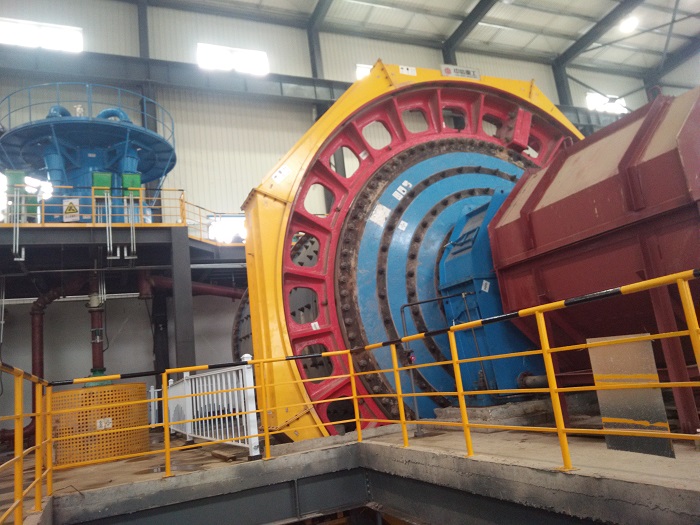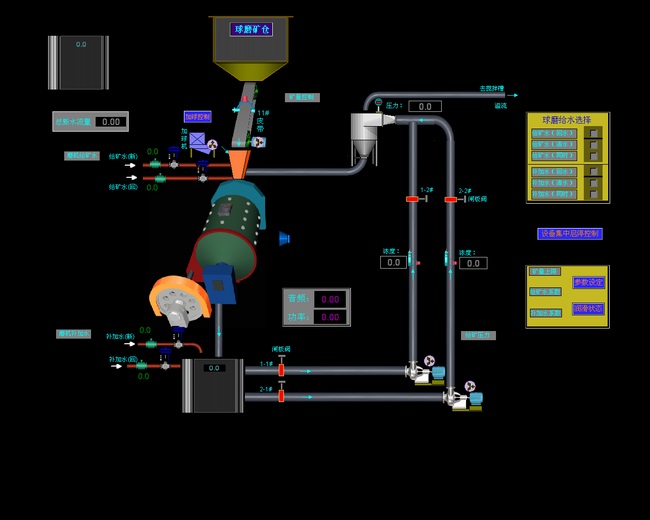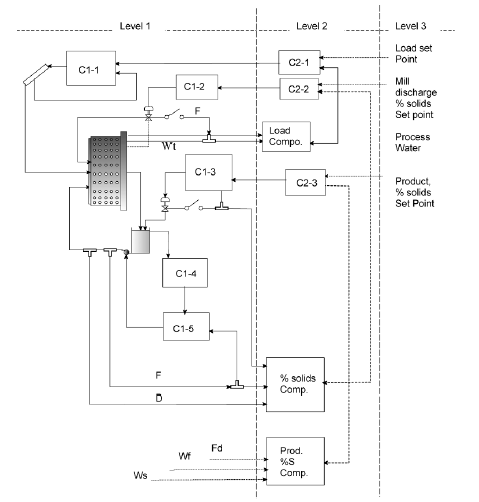The principle objective for controlling grinding mill operation is to produce a product having an acceptable and constant size distribution at optimum cost. To achieve this objective an attempt is made to stabilize the operation by principally controlling the process variables. The main disturbances in a grinding circuit are;
1.change in ore characteristics (ore feed rate, grindability, feed particle size distribution, mineral composition and mineral characteristics like abrasiveness, hardness),
2.changes in mill operating parameters like variation of input flow rate of material like surging of feed caused by pumps and level of mill discharge sump.

The mill control strategy has to compensate for these variations and minimize any disturbances to the hydrocyclone that is usually in closed circuit. The simplest arrangement is to setup several control loops starting from the control of water/solid ratio in the feed slurry, sump level control, density control of pulp streams at various stages and control of circulating load. Presently most mills use centrifugal pumps for discharging from the sump. This helps to counter surges and other problems related to pumping. For feed control the most likely option is to use a feed forward control while for controlling the hopper level and mill speed and other loops the PI or PID controller is used. The control action should be fast enough to prevent the sump from overflowing or drying out. This can be attained by a cascade control system. The set point of the controller is determined from the level control loop. This type of control promotes stability.

As an example, for completely controlling a grinding mill circuit the operation of a SAG mill is considered here as these mills seem to be slowly displacing the normal ball mill operations.
The SAG mill characteristics have already been mentioned earlier in Chapter 9. The main variables are:
1. solid mass transported through the mill ( solid feed plus the circulation load),
2. the mill discharge solids, and
3. the overflow solid flow.
From the control point of view, the additional interests are:
1. overfilling of the mill,
2. grate restrictions and,
3. power draft.
Each of these is controlled by specific controlled inputs, i.e., feed rate, feed water and discharge water flows. The overflow solids fraction is controlled by monitoring the ratio of total water addition (WTOT) to the solid feed rate. The ratio being fixed by the target set point of the overflow solid fraction.
Usually the charge volume of SAG mills occupy between 30-40% of its internal volume at which the grinding rate is maximized. When the charge volume is more, then the throughput suffers. The fill level is monitored by mill weight measurement as most modern mills are invariably mounted on load-cells.
During the operation of SAG mills, it is sometimes observed that the sump levels fall sharply and so does the power draft. This phenomenon is attributed to flow restrictions against the grate. When this occurs it is necessary to control, (or in extreme circumstances), stop the incoming feed.
The power draft is the result of the torque produced by the mill charge density, lift angle of the charge within the mill and fill level. The relationship between these parameters is complex and difficult. Therefore to control mill operation by power draft alone is difficult.
For the purpose of stabilization of the circuit, the basis is to counteract the disturbances.
Also the set points must be held. The set points are attributed by dynamic mass balances at each stage of the circuit.
In modern practice the structure and instrumentation of the control systems of tubular grinding mills are designed to operate in three levels or in some cases four levels. The control loops and sensors for a SAG-mill and the levels of control are illustrated in Fig. 1

Level 1
The operation at Level 1 mainly consists of controlling the feed rate and the water inputs. In addition to this the SAG mill revolving speed and secondary circulating load also forms ancillary loops.
There are four main control loops in Level 1 (Table 1).
Table 1. Control loop of SAG mill

The main sensors are:
1. load cell for mill weight,
2. power measurement (ammeters, voltmeters), and
3. density gauges (y-ray density gauge) for on line, non-invasive, measurement of slurry densities.
Level 2
The function of Level 2 is to stabilize the circuit and to provide the basis of optimizing function in Level 3. Three cascade loops operating in level 2 controls that function in conjunction with level 1 controllers. The cascade loops are:
1. mill load feed rate (controlled by feeder speed),
2. mill discharge, (% solids)
3. mill product, (% solids).
The set points are supplied by level 3 controllers for all the cascade loops. The mill load and percent solids in the two streams are calculated from signals received by sensors in the water flow stream, the sump discharge flow rate and the density readings from density meters in the pulp streams. The mill load cells supply the charge mass. The load cell signals are compensated for pinion up thrust.
The set points for the mill load and the two pulp densities are given by level 3 controls.
The points may also be set by neural method of analysis or fuzzy logic expert systems.
To determine the set point for the optimum mill load, a relation between load, consisting of different feed blends and performance (the maximum achievable throughput) is established.
Similar observations are made for mill discharge density and mill discharge flow.
For some routine standard situations ready made supervisory work station computer programs, especially for Levels 1 and 2, are available.
Level 3
The primary function at Level 3 is optimisation of the SAG mill operation. That is, control of the product at optimum level. In an integrated situation where ball mill and cyclone is in the circuit, the optimisation must take place keeping in mind the restraints imposed by down stream requirements. This optimisation can best be achieved by developing a software for computer use. Usually a large database is required to cover infrequent control actions.